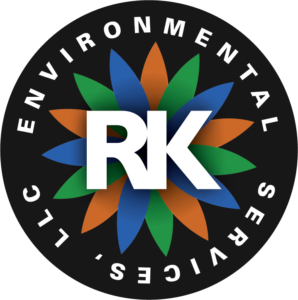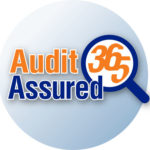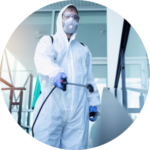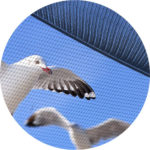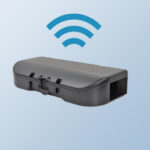Introduction to Salmonella
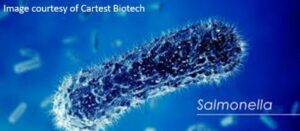
When one hears the name “salmonella,” most think of eggs and poultry and “food poisoning.” Salmonella is not only know for making people sick through poultry and eggs, but a wide variety of foods. This bacterium is widespread and very common.
Salmonella is a complicated genus of rod-shaped gram-negative bacteria of the family Enterobacteriaceae. There are more than 2,500 Salmonella serotypes, or distinct variations, and it is estimated that less than 100 of them cause human illness, according to the United States Department of Agriculture (USDA). Salmonella enteriditis and Salmonella typhimurium, the two most important serotypes for salmonellosis transmitted from animals to humans. Transmission of Salmonella occurs through contaminated food (poultry, poultry products, beef, pork, eggs, milk, and seafood), water or contact with infected animals.
In 2022 there were dozens of recalls due to salmonella and many underreported illnesses or cases of Salmonellosis, even with approximately 40,000 cases of salmonellosis being reported in the United States, many cases are shrugged off as simple “food poisoning” and not validated and tracked. These recalls, outbreaks, etc. were not limited to foods of animal origin but included spices, fruits, nut butters, seeds, vegetables, sprouts, and flours.
At the manufacturing/production step in the supply chain is often where the contamination occurs and can be prevented thorough proper sanitation, employee practices and environmental monitoring. Manufacturers should conduct comprehensive risk assessments to determine their susceptibility for cross-contamination with salmonella and other vegetative pathogens. At the consumer level, proper hygiene and sanitation in the home is essential. Consumers should ensure they wash their hands frequently when preparing meals, clean and sanitize work surfaces and cook foods thoroughly. Additional information is available through the USDA’s website.
Submitted by: Rich Gibson, ACE, CFSQA
RK Environmental Services
The Rice Weevil
Order: Coleoptera Family: Curculionidae Genus: Sitophilus Species: S. oryzae
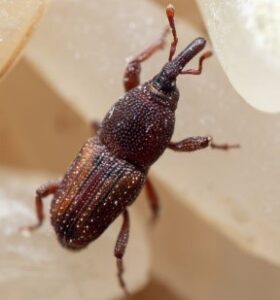
The rice weevil (Sitophilus oryzae) is a stored product pest which attacks seeds of several crops, including wheat, rice, and maize. Adult Rice Weevils are very small; between 3 and 4.6 mm long, with a long snout. The body color appears to be brown/black, but on close examination, four orange/red spots are arranged in a cross on the wing covers. It is easily confused with the similar looking maize weevil.
Adult rice weevils can fly and may live for up to two years in ideal conditions. Females lay anywhere between 2 and 6 eggs daily, and up to 300 over their lifetime. The female uses her mandibles to chew a hole into a grain kernel, then deposits a single egg within the hole, sealing it with secretions from her ovipositor. Control of weevils involves locating and removing all potentially infested food sources. Rice weevils in all stages of development can be killed by freezing infested food below 0 °F for a period of three days, or heating to 140 °F for 15 minutes. Commodities infested with weevils can also be fumigated.
Submitted by: Rich Gibson, ACE, CFSQA
RK Environmental Services
Closing the Gap in Record Time
In early February 2023, a food processing company’s Quality Assurance Manager / SQF Practitioner resigned suddenly, and the Substitute Practitioner was not as familiar with the SQF Program as they should have been. The site’s leadership team conducted a deep dive into the files and discovered numerous gaps in the program’s overall effectiveness. This was discovery occurred only three weeks before their scheduled SQF audit.
The site’s Senior Management Team contacted Comprehensive Food Safety (CFS) with an urgent request for assistance. A phone meeting was scheduled for the next day, and from that call it was determined that CFS was perfectly positioned to provide the immediate and critical assistance the site so desperately needed. The CFS team was able to free up from other projects one of their highly skilled Food Safety Consultants. The consultant scheduled a visit the next week and was on site for two days.
During the site visit, a gap assessment and mock SQF audit were conducted. The results of the assessment and audit revealed that many areas of improvement were needed to ensure compliance to the SQF Food Safey Code. Several gaps in the site’s food safety management system documents were noted, and the plant inspection also identified several actual and potential non-conformances. Drawing from the experience of the Consultant assigned to the project, the actual and potential nonconformances were identified, and practical, cost-effective solutions were presented to the management team. Simultaneously, CFS was able to recommend a clear path to correct the deficiencies. An actionable report was presented to the site leadership, and a follow up meeting was held to review the findings and plan actions to close those gaps.
Two weeks later, the site had their SQF audit, and at that time an “Excellent” rating was assigned, the highest rating possible. This is a direct result not only of the site’s diligent efforts to rebound and Management Commitment, but also of the hard work, expertise, and ability for CFS to pivot on short notice and provide clients with both immediate and longer-term solutions to mitigate and manage their food safety concerns and programs.
Take Away Tips:
- A fresh set of eyes can be helpful
- When in doubt use an experienced expert
- Solutions are often easier than you think
- Collaboration is an essential tool in many situations
Submitted by: Joe Laino
Senior Food Safety Consultant
RK Environmental Services
